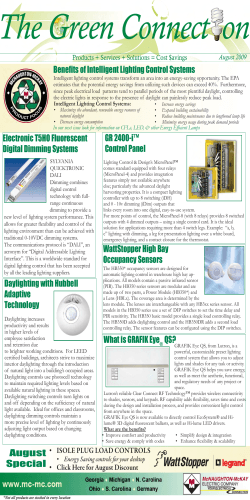
in this PDF document
UC Davis Smart Lighting Initiative General user information and training – Non-Networked March 19th, 2015 Smart Lighting Initiative Phase 2 SLI Objectives Reduce Campus electrical lighting energy consumption 60 percent by 2015 • 2007 as the base year • Savings over 15 years to pay for investments • Additional benefits – Leveraging the California Lighting Technology Center and UC Davis Energy Efficiency Center – Promoting the campus as a technology and sustainability leader – Inspiring Campus ties with the CPUC and PG&E – Shrinking UC Davis carbon footprint – Improving lighting quality – Enhancing safety and security – Assisting with lighting maintenance program – Savings from reduced cooling needs – Taking advantage of available incentives Smart Lighting Initiative Phase 2 SLI Phase 2 Buildings • 43 buildings • 2.5 mil Gross square feet (20% of Campus MGSF) • Post-1985 construction Smart Lighting Initiative Phase 2 SLI Phase 2 Proposed Lighting Modifications 2% 11% 30% LED Volumetric - Retrofit 14% New LED Fluorescent Volumetric - Retrofit 5% 38% Reduced power fluorescent Others Recessed LED - Retrofit *Volumetric: reflective light housing, high illumination, 3 dimensional imagery lighting distribution Smart Lighting Initiative Phase 2 Lighting Knowledge Lighting Temperature •Previous – 3500K •New – 4100K Lighting Type: •LED – Light Emitting Diode •Fluorescent Controls: •Switch – turn lights on/off, dim •Occupancy Sensor – switch or ceiling mounted •Photocell – based on light entering windows. Smart Lighting Initiative Phase 2 Lighting Types EPA – •LED •Fluorescent •Used to replace inefficient parabolic fixtures Smart Lighting Initiative Phase 2 Lighting Types Rebuilds: •Mostly 1x4 fixtures •Where retrofit will not fit in 2x4 Smart Lighting Initiative Phase 2 Switch Types Rocker switch: •Used in larger spaces •Where ceiling mounted Occ sensor is used On/off - Dimmer Red LED sensor indicator light On / Brighter Off / Dimmer Occ Sensor Single Button Occ switch: •Used for dimming switching •Occ Sensor integrated in switch Smart Lighting Initiative Phase 2 Switch Types Scene switch: •Used in larger spaces / Conference rooms / Presentation spaces •Pre-determined settings Two Button switch: •Used for A/B switching •No dimming associated Smart Lighting Initiative Phase 2 Occupancy Sensor Types Ultrasonic Occ Sensor: •Uses ultrasonic wave to determine presence •Used in hallways and spaces that do not have direct line of sight IR window – programming Sensor indicators IR Occ Sensor: •Uses infrared signal to determine presence by motion of heat. •Used offices and open spaces – may have multiple units in one space Smart Lighting Initiative Phase 2 Troubleshooting What to look for: Lighting: Some lights can take up to two to three seconds to respond – Why? • Switch can take up to .5 seconds to respond. • Fluorescent lights can take an additional 2 seconds to respond due to program start. • Fluorescent lights – look for a quick flicker at the ends of the fixture – this indicates that the lamp is starting – if the lamp does not light in 2 to 3 seconds, • Call in and report. Occupancy sensor: Two types – Ultrasound • Ultrasound uses sound waves to determine occupancy • Blue light flashes when movement is detected in one of the sound cones • Provides wider coverage Occupancy sensor: - and Infrared • Uses an IR signal to detect heat • Center circle is the sensor • Red light flashes when movement is recognized • Easier to adjust sensitivity. Smart Lighting Initiative Phase 2 Troubleshooting What the…. Why does my light go out why I’m still there? • You must make a major motion to activate the sensor/timer to avoid a time-out. This is an arm movement across the sensor area – faster is not always better. • On IR, the detector is cone shaped and best to move perpendicular to this detector (ie – up and down arm movement for wall sensor, back and forth for ceiling sensor. • Time-out times are set for 20 minutes – this is a single timer, so the same time for lights off as for lights on. 30 minutes is maximum as dictated by CPUC Who should I call / email? • Consult the training manual. The instructions are straight forward, but there are a few tips you learned during this session. • Have your personnel ask someone who has been to this training for some help. • If still operating erratically or not at all, contact Facilities OM Customer Service. Why didn’t my lights get changed? •Design decision based on lighting density, space use, existing controls and capital resources Smart Lighting Initiative Phase 2 Smart Lighting Initiative Phase 2
© Copyright 2026









